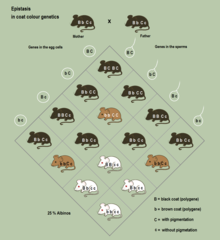
Back الحجب الجيني (التفاعل الجيني) Arabic Epistaza BS Epístasi Catalan Epistáze Czech Epistasi Danish Epistase German Επίσταση (βιολογία) Greek Epistasia Spanish Epistasi Basque اپیستازی Persian


Epistasis is a phenomenon in genetics in which the effect of a gene mutation is dependent on the presence or absence of mutations in one or more other genes, respectively termed modifier genes. In other words, the effect of the mutation is dependent on the genetic background in which it appears.[2] Epistatic mutations therefore have different effects on their own than when they occur together. Originally, the term epistasis specifically meant that the effect of a gene variant is masked by that of different gene.[3]
The concept of epistasis originated in genetics in 1907[4] but is now used in biochemistry, computational biology and evolutionary biology. The phenomenon arises due to interactions, either between genes (such as mutations also being needed in regulators of gene expression) or within them (multiple mutations being needed before the gene loses function), leading to non-linear effects. Epistasis has a great influence on the shape of evolutionary landscapes, which leads to profound consequences for evolution and for the evolvability of phenotypic traits.
- ^ Neil A. Campbell, Jane B. Reece: Biologie. Spektrum-Verlag Heidelberg-Berlin 2003, ISBN 3-8274-1352-4, page 306
- ^ Gros PA, Le Nagard H, Tenaillon O (May 2009). "The Evolution of Epistasis and its Links with Genetic Robustness, Complexity and Drift in a Phenotypic Model of Adaptation". Genetics. 182 (1): 277–93. doi:10.1534/genetics.108.099127. PMC 2674823. PMID 19279327.
- ^ Rieger R, Michaelis A, Green MM (1968), A Glossary of Genetics and Cytogenetics: Classical and Molecular, New York: Springer-Verlag, ISBN 978-0-387-07668-3
- ^ Richmond, Marsha L. (2001). "Women in the Early History of Genetics: William Bateson and the Newnham College Mendelians, 1900–1910". Isis. 92 (1). The History of Science Society: 55–90. doi:10.1086/385040. JSTOR 237327. PMID 11441497. S2CID 29790111.
© MMXXIII Rich X Search. We shall prevail. All rights reserved. Rich X Search